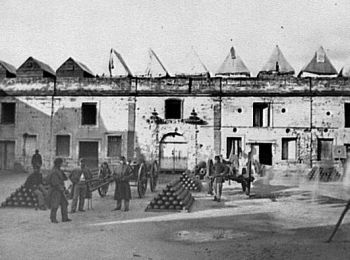St. Augustine, Florida, a slave trade center of the Southeast, has been under Union control since the capture of the city on March 11 by the United States Navy. The following day, Jacksonville fell to the Union Navy. In both cities slaves were freed while white citizens’ communication with the Confederacy was curtailed.
Four days ago, the city of St. Augustine was placed under martial law in response to ongoing, unauthorized citizen contact with “the enemy.” According to Union officers, however, white citizens are able to carry on their lives with minimal disruption.
Today, Lt. Col. Louis Bell, of the 4th New Hampshire Volunteers and the commanding officer in St. Augustine, reports on the state of affairs in the captured city:
Saint Augustine, FLA., April 15, 1862.
Brig. Gen. H. W. BENHAM,
Comdg. Northern District, Department of the South:
I have the honor to report that (finding a constant communication was kept up between the inhabitants of this city and the enemy and that the members of the city government would not assist me in preventing it) I placed the city under martial law on the 12th instant. The day after a re-enforcement of four companies of my regiment arrived. I should have replaced the city officials in power had not the feeling among the citizens been that they desired martial law to still remain. I am pleased to be able to report that no ill-feeling or difficulty has arisen between the citizens and the men of my command, and that not an instance of any insult or unpleasant feeling has taken place. I have prohibited any person passing the line of my command without taking the oath of allegiance. Fort Marion has now mounted two 8-inch sea-coast howitzers, one 32-pounder gun, four iron 6-pounder guns, one brass 6-pounder gun, one 24-pounder siege howitzer, and a Wiard rifled gun. Lieutenant Tardy, U.S. Corps Engineers, has arrived at this post and taken charge of putting the fort in a state of defense. Lieutenant Tardy intends to mount two 8-inch columbiads on the fort. With the ordnance stores I have drawn a requisition for I can defend the post against all the enemy now in arms in Florida. I have the honor to request instructions as to slaves belonging to disloyal men. I have retained such slaves, furnishing them with food and compelling them to work, and simply excluding other slaves from the fort. This city is in a most lamentable condition with respect to food. I have been compelled to issue Government provisions to families to prevent them from perishing from hunger. I have the honor to request instructions as to whether such issues will be permitted. Five deserters from the enemy have come in; no information of any importance has been got from them, except that one of the Saint Augustine companies wished to lay down their arms and surrender. I have used every effort to inform them that they might return here and remain unmolested.
I take the liberty of suggesting again that the ordnance stores I have drawn a requisition for are very necessary for the defense of my post.
I have the honor to be, sir, your obedient servant,
LOUIS BELL,
Lieut. Col., Comdg. Fourth New Hampshire Volunteers, Commanding Post of Saint Augustine.
Among former slaves now exercising freedom of movement is black evangelist Ivey Barnes of Jacksonville. Traveling between his home town and St. Augustine, Barnes leads church meetings in the home of Deacon John Newnan. For the present, the meetings in Deacon Newman’s home are small affairs. In the coming months, the ebb and flow of Union strength in and around Jacksonville hamper movements of freed slaves. Yet within two years a Sunday School will be started in Deacon Newman’s home, eventually leading to the formation of St. Augustine’s First Baptist Church.
Sources: Dale Cox, “The Surrender of St. Augustine, Florida” (link); “First Union Occupation of Jacksonville, March-April 1862” at the Civil War Jacksonville website (link); “Civil War, Jacksonville” (link); Lt. Col. Louis Bell’s letter in Miscellaneous Documents of the House of Representatives for the First Session of the Forty-Ninth Congress, 1885-1886, pp. 333-344 (link); “St. Augustine in the Civil War” (link); Photo of Fort Marion, Samuel Cooley, Library of Congress (link)



